The History Of OPEL Ascona

The Opel Ascona was a mid-sized car produced by Opel, the German subsidiary of General Motors. It had three generations produced from 1970 to 1988. In motorsport, the Ascona 400 rally car driven by Walter Röhrl won the World Rally Championship drivers' title in the 1982 season.
In the fall of 1970, Opel presented its completely new vehicle range in Rüsselsheim (internal project code 1.450). The Opel Manta coupé was launched on September 9, followed by the Opel Ascona on October 28 in two and four-door sedan forms, plus a three-door station wagon, called the Caravan or Voyage. These models were positioned between the existing Opel Kadett and the Opel Rekord.
The Opel Ascona was developed to as a competitor to the successful Ford mid-sized car, the Taunus. The Opel Ascona A stayed in production until 1975. By that time, almost 692,000 vehicles of the first series had been produced.
The range featured petrol engines from 1.2L to 1.9L, with power between 60PS (44kW) and 90PS (66kW). The 1.2L had an overhead valve(OHV) head, while the 1.6L and 1.9L featured a camshaft in head (CIH) type of engine. All used a single barrel carburetor. Even with this simple design, the Ascona 1.9 SR had a successful career in motorsports, with Walter Rohrl winning the European Rally Championship in 1974. Tuner Steinmetz developed a special version of the Ascona SR, with two single-barrel Solex carburettors, lifting power to 125PS (92kW).
In 1975, a small number of 2 door 1.9 L sedans were exported as the "Opel 1900" to the United States, sold through Buick dealerships as the Buick-Opel. All Opels sold in the US in 1975 were equipped with Bosch K-Jetronic fuel injection, which was not available on the European versions. The fuel injection was added because of the more strict emissions requirements that were in force that year. Due to the unfavorable DMark/ US Dollar exchange rate, after 1975, all Opels in Buick showrooms were replaced by Isuzu Gemini models wearing Opel badges.
Engines
- 1.2 S - 1196cc, 60PS (44kW)
- 1.6 N - 1584cc, 60-68PS (44-50kW)
- 1.6 S - 1584cc, 75-80PS (55-59kW)
- 1.9 S - 1897cc, 88-90PS (65-66kW)
The second generation Opel Ascona B was presented in the 1975 Frankfurt Motor Show. It was available as a two or four-door sedan. There were related two and three-door coupé models in the Opel Manta range. There was no estate body.
The Ascona B retained the same engine range as its predecessor, although the 1.9L was increased to 2.0L in 1978, and versions with higher compression ratio and needing 98 octane gas, dubbed S, were available alongside the 90 octane models. The 2.0 E model had a Bosch L-Jetronic electronic fuel injection, and a 2.0L diesel motor was added to the Ascona B range in 1978.
In the United Kingdom, the Vauxhall Cavalier badge was used on both saloon and coupé models, which came out of the same factory in Belgium—the first Vauxhall to be built abroad. The front ends were different, featuring Vauxhall's trademark "droop snoot", as designed by Wayne Cherry.
A version of the Ascona B, featuring the front end of the Manta B, was sold in South Africa as the Chevrolet Chevair. This was in addition to a Chevrolet Ascona, identical in most respects to the Opel.
Over 1.2 million Ascona B units were produced worldwide until 1981.
Timeline
- August 1975 - Start of production of the Ascona B.
- January 1976 - Laminated window glass available as an option without extra cost.
- September 1977 - New 2.0 Liter engine (20S with 100 PS) from the Rekord E with hydraulic tappets replaces the 19S engine. New boot lock with turn handle available as special equipment.
- January 1978 - New 2.0 Liter engine (20N with 90 PS) introduced. All models now have electric windscreen washers.
- January 1979 - Introduction of the Ascona 400 with 2.4-liter engine (16 valve, 144 bhp). This was the Street version.
- February 1979 - The 1.3 OHC engine replaces the previous 1.2 OHV engine.
- September 1979 - A minor facelift, including plastic bumpers and grey front grille
- January 1980 - New fuel-injected 2.0E engine with 110hp (82kW) now available in the Ascona.
- January 1981 - Adjustments made to the 16N and 20N engines. 1.6 N engine only available with an automatic transmission
- August 1981 - Production ends.
Engines
- 1.2 N - 1196cc, 55PS (40kW)
- 1.2 S - 1196cc, 60PS (44kW)
- 1.3 N - 1297cc, 60PS (44kW)
- 1.3 S - 1297cc, 75PS (55kW)
- 1.6 N - 1584cc, 60PS (44kW)
- 1.6 S - 1584cc, 75PS (55kW)
- 1.9 N - 1897cc, 75PS (55kW)
- 1.9 S - 1897cc, 90PS (66kW)
- 2.0 N - 1979cc, 90PS (66kW)
- 2.0 S - 1979cc, 100PS (74kW)
- 2.0 E - 1979cc, 110PS (81kW)
- 2.1 D - 2068cc, 58PS (43kW)
- 2.4 I - 2420cc, 144PS (106kW)
Ascona 400 rally car
The reason why many probably remember the Ascona B series well is because of the rally version of the car. Built in 1981, the 1980 world champion Walter Röhrl took the car to victory and won the World Rally Championship drivers' title in the 1982 season.
The car was developed by Opel alongside the Manta B 400 model which consisted of the same changes. Irmscher and Cosworth were hired as partners for the project, Cosworth to deliver a 16 valve double cam crossflow head for the engine, and Irmscher for the exterior and interior styling. Cosworth delivered the heads to Opel and Opel soon discovered a major mistake. The plan was to use the 2,0 litre engine block but this did not produce enough power. Time was running out and Opel badly needed to do something. Opel took the 2,0E block and gave it an overbore, installed larger pistons, other pistonrods, and installed the crankshaft of their 2,3 litre diesel CIH style engine. Results was a 2,4 litre engine. The 2,4 litre engine gave way to some massive power outputs using the 16 valve head. The street versions of the 400 therefore came with 144bhp (107kW; 146PS) engines, using the Bosch fuel injection of the Manta GSi and GT/ E series. However in race trim they were delivered putting out some 230bhp (172kW; 233PS), which could be improved further to a staggering 340bhp (254kW; 345PS) + still using normally aspirated engine components.
Irmscher delivered the rally trim for the exterior. Large and widened wings, light weight doors, hood, front wings, rear boot lid and doors were installed keeping the weight down.
In 1984, the Audi Quattro appeared more powerful than ever and the Ascona 400 was rendered obsolete. But the Ascona 400 still has some remarkable records. The Ascona 400 was the last rear wheel drive rally car to win the world championship, ensuring its place in the motorsports book of history.
The Ascona C was launched in August 1981 as part of General Motors' J-car project. This was Opel's second front-wheel drive car since the introduction of the Kadett D in 1979. This car was manufactured in Russelsheim, Germany, Antwerp, Belgium and Luton, England, and was sold in the UK under the name Vauxhall Cavalier. The Cavalier Coupé was phased out, but the Opel Manta was retained in the UK (the last car to be badged as an Opel in the UK before the brand was phased out in 1988). There were no longer sheet metal differences between Opel and Vauxhall models after 1982. The Ascona C won the "Golden Lenkrad" at the end of 1981 and was West Germany's biggest selling car.
The range added an option of a five-door hatchback bodystyle, named CC in a few markets. All engines were now SOHC. The base model was the 1.3L introduced in 1978 in the Ascona B, with 60PS (44kW), followed by a 1.6L with 75PS (55kW). S versions with higher compression ratio had power increased by as much a 20 percent. The top of the line was the sporty GTE model, with electronic fuel injection, pushing power to 130PS (96kW). Diesel power came from an Isuzu-developed block, with 1.6L. Catalytic converters were optional in the larger petrol units starting from 1986.
As before, there was no station wagon version of the Ascona, although Vauxhall in the UK brought in the rear ends of the Holden Camira wagon and adapted them to the Cavalier.
In Brazil, the Ascona C was sold as a coupé, hatchback and sedan from 1982 to 1996 as Chevrolet Monza , receiving various facelifts. In Colombia was sold as sedan from 1987 to 1992.
In South Africa, the Ascona C was sold as a sedan and hatchback from 1982 to 1986, when it was replaced by the sedan version of the Kadett, known as the Opel Monza (In Europe, this name was used for a coupé version of the larger Senator).
Opel continued to use the Ascona nameplate until the Vectra was launched in 1988, although the Cavalier name was retained by Vauxhall until 1995.
Timeline
- September 1981 - Introduction of the Ascona C as the successor for the Ascona B. Available bodystyles for the Ascona included 2- and 4-door Sedans, a 5-door Hatchback (the CC) and later on a 5-door Estate. Initial engine choice included the 1.3N (60 bhp), 1.3S (75 bhp), 1.6N (75 bhp) and 1.6S (90 bhp), all of which had a four-speed gearbox or optional three-speed automatic transmission for all except the 1.3 N. Trim variations included Base, L, Berlina and SR.
- 1982 - Introduction of the Ascona Diesel with a 1.6 (55 bhp) engine. Introduction of the Ascona CD with higher level of equipment. New 1.8E engine with LE-Jetronic (115 bhp) and five-speed gearbox. Optional power steering, electric windows, electric mirrors and computer available at extra cost.
- 1983 - Modified ignition switch and door locks. Improvements made to water pump, valve seals and radiator hoses. New Ascona Convertible available. Optional central locking and heated mirrors. Optional Sports suspension available for SR and 1.8 E engine. Automatically adjustable rear brakes now standard.
- 1984 - All models have facelift with new CD-style radiator grille, new wheel trims, new front seat mountings, modified center console, remote-adjustable door mirrors and height-adjustable steering wheel. 1.3S engine now has new start-stop system. Improved clutch damping and headlight seals. Model names also changed: Base becomes LS, L becomes GL, Berlina becomes GLS, and SR becomes GT.
- 1985 - 1.8i engine with three-way catalyst introduced. One-way catalysts available for all engines. Modified clutch lining and door seals.
- 1986 - All models have facelift, this time with clear front indicator lenses, dark taillight lenses, colour-keyed radiator grille, air vent, and front spoiler. GT now has front and rear spoilers.
- 1987 - New engines available: 1.6i and 2.0i with three-way catalysts. 1.6 has Multec-central Injection system and 75bhp (56kW; 76PS), while 2.0 has Bosch Motronic Injection system and 115bhp (86kW; 117PS). Non-catalyst 2.0i gives 130bhp (97kW; 132PS).
- August 1988 - End of production for the Ascona C, replaced by the Opel Vectra A.
Engines
- 1.3 N - 1297cc, 60PS (44kW)
- 1.3 S - 1297cc, 75PS (55kW)
- 1.6 N - 1598cc, 75PS (55kW)
- 1.6 E - 1598cc, 75PS (55kW)
- 1.6 S - 1598cc, 82-90PS (60-66kW)
- 1.8 N - 1796cc, 84PS (62kW)
- 1.8 E - 1796 cccc, 100-115PS (74-85kW)
- 2.0 E - 1998 cccc, 100-115PS (74-85kW)
- 2.0 GT - 1998 cccc, 130PS (96kW)
- 1.6 D - 1598cc, 54PS (40kW)
From Wikipedia, the free encyclopedia
More About OPEL Ascona
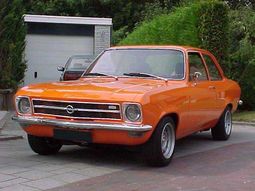

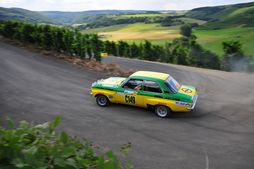
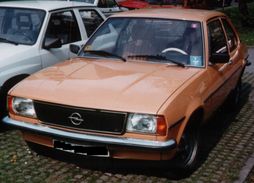
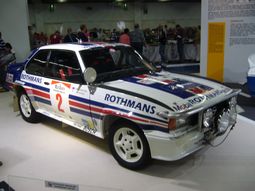
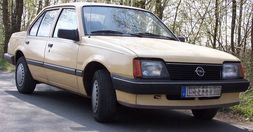

|